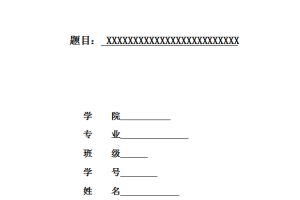摘 要
目前,医疗设备的装备程度和管理水平也已成为医院现代化程度的重要标志之一和提供医疗服务的重要保障。这就对一家医院如何对医疗设备的管理与运营、资产的保值增值、设备的更新、淘汰、维护、效益分析等提出了更高要求。近些年以来,随着电子信息技术的快速发展,医院对设备管理的重视程度的增强,信息化建设和设备管理也得到相应的发展和应用,不同部门都建立了相应的信息平台来提高管理水平和工作效率,如:门诊挂号、开药、收费、发药为基础的HIS(Hospital Information System)系统;实验室LIS系统;影像科PACS系统等。设备管理却一直没有在信息化方面得到应有的建设和发展。本文就当前设备科信息化急速发展和提升的大背景下,介绍一种医院设备管理系统的设计和实现方案,从而可以实行对医疗设备科学、有序、有效、全面、直观”的管理,实现医院对设备要求规范化、科学化、全程化、精细化的管理目标,保障医院设备的运行效率,发挥设备的最大潜力,优化医疗设备资源配置,规范医疗耗材流转,规避资产运行风险。
关键词:设备管理,SPRINGMVC,SHIRO,Web服务
Abstract
At present,the level of equipment and management has become an important symbol of the modernization of hospitals and provide an important guarantee for medical services.It puts forward higher requirements on the management and operation of medical equipment,the maintenance and increment of assets,the update of equipment,the elimination,maintenance and benefit analysis of a hospital.
With the rapid development of electronic information technology,hospital management software and information construction has also been widely used and developed,such as: HIS、LIS and PACS system. Equipment management has not been build and develop in information technology.
Under this background ,introduce a kind of hospital equipment management system design and realization of the program, which can implement the management of medical equipment, scientific, orderly and effective, comprehensive and intuitive, the realization of hospital equipment requirements specification,scientific,the whole and the refinement of management objectives,guarantee the efficiency of hospital equipment,equipment to play the greatest potential, optimize the allocation of resources for medical equipment, regulate the transfer of medical supplies, to avoid risk of asset operation.
Keywords:equipment management,SPRINGMVC,SHIRO,Web service
摘 要……………………………………………………………………………………………………………. I
Abstract………………………………………………………………………………………………………….. II
图目录…………………………………………………………………………………………………………. VII
表目录…………………………………………………………………………………………………………. VIII
第一章 引言………………………………………………………………………………………………… 1
1.1 项目背景………………………………………………………………………………………….. 1
1.1.1建立医院设备管理系统的必要性……………………………………………… 1
1.1.2建立医院设备管理系统的迫切性……………………………………………… 2
1.2 本文选题来源和主要工作…………………………………………………………………. 3
1.3 本文的组织结构……………………………………………………………………………….. 3
第二章 相关技术介绍………………………………………………………………………………….. 1
2.1 SPRING MVC…………………………………………………………………………………… 1
2.1.1 概述……………………………………………………………………………………….. 1
2.1.2 框架……………………………………………………………………………………….. 1
2.1.3 Spring MVC优势…………………………………………………………………………… 1
2.2 HIBERNATE……………………………………………………………………………………… 3
2.2.1 概述……………………………………………………………………………………….. 3
2.2.2 HIBERNATE 优势…………………………………………………………………… 3
2.2.3 HIBERNATE 核心接口和类…………………………………………………….. 4
2.3 AJAX………………………………………………………………………………………………… 5
2.3.1 概述……………………………………………………………………………………….. 5
2.3.2 AJAX优势………………………………………………………………………………. 5
2.4 SHIRO………………………………………………………………………………………………. 6
2.4.1 概述……………………………………………………………………………………….. 6
2.4.2 身份授权和验证……………………………………………………………………… 7
2.5 MVC…………………………………………………………………………………………………. 7
2.5.1 概述……………………………………………………………………………………….. 7
2.5.2 MVC组成部分………………………………………………………………………… 8
2.5.3 Spring MVC 和SHIRO整合………………………………………………………….. 9
2.6 本章小结………………………………………………………………………………………… 11
第三章 系统需求分析………………………………………………………………………………… 12
3.1系统目标…………………………………………………………………………………………. 12
3.2 系统功能需求分析………………………………………………………………………….. 13
3.2.1登陆模块………………………………………………………………………………. 13
3.2.2资产管理设备新增………………………………………………………………… 13
3.2.3设备维保信息修改………………………………………………………………… 14
3.2.4维保工单登记……………………………………………………………………….. 14
3.2.5维保工单受理……………………………………………………………………….. 14
3.2.6维保工单统计……………………………………………………………………….. 15
3.3系统非功能需求分析……………………………………………………………………….. 16
3.3.1安全性………………………………………………………………………………….. 16
3.3.2可靠性………………………………………………………………………………….. 16
3.3.3易用性………………………………………………………………………………….. 16
3.3.4通用性………………………………………………………………………………….. 16
3.3.5性能需求………………………………………………………………………………. 17
3.4 本章小结………………………………………………………………………………………… 17
第四章 信访维稳系统的实现……………………………………………………………………… 18
4.1系统框架结构设计…………………………………………………………………………… 18
4.1.1概述……………………………………………………………………………………… 18
4.2系统模块结构设计…………………………………………………………………………… 23
4.3 数据库设计…………………………………………………………………………………….. 24
4.3.1工单模块数据库设计…………………………………………………………….. 24
4.3.2 权限数据库表设计……………………………………………………………….. 25
4.4 本章小结………………………………………………………………………………………… 26
第五章 系统配置类模块详细设计与实现……………………………………………………. 27
5.1 登陆管理系统…………………………………………………………………………………. 27
5.2 资产管理设备新增………………………………………………………………………….. 29
5.3 设备维保信息修改………………………………………………………………………….. 30
5.4 维保工单登记…………………………………………………………………………………. 32
5.5 维保工单受理…………………………………………………………………………………. 33
5.6 维保工单统计…………………………………………………………………………………. 35
5.7本章小结…………………………………………………………………………………………. 38
第六章 总结与展望……………………………………………………………………………………. 27
6.1总结………………………………………………………………………………………………… 39
6.2系统实施效果………………………………………………………………………………….. 40
6.3工作展望…………………………………………………………………………………………. 40
参 考 文 献………………………………………………………………………………………………… 42
致 谢………………………………………………………………………………………………….. 43
参 与 项 目………………………………………………………………………………………………… 44
版权及论文原创性说明………………………………………………………………………………… 45





